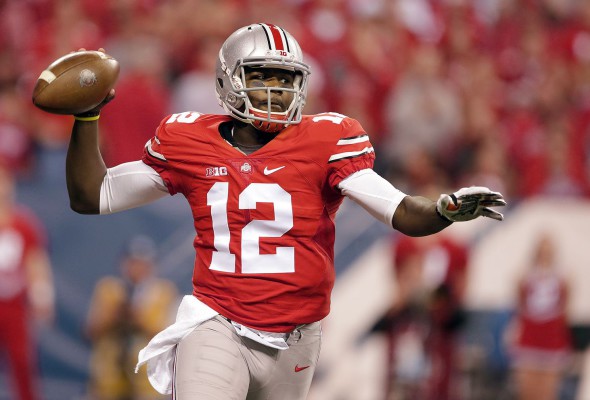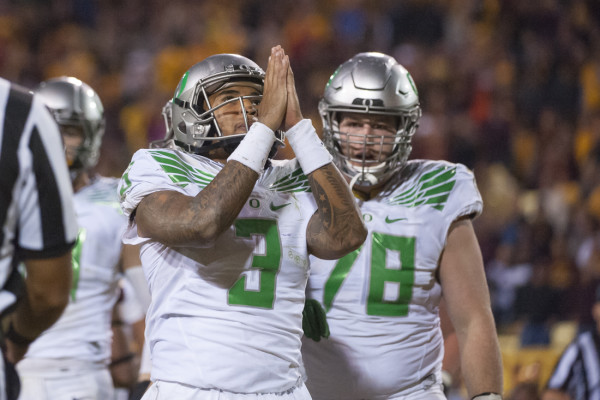Potential Starter: Brandon Allen, Arkansas
Before the start of the 2015 season, the Razorbacks quarterback was considered another decent college player with a zero chance of making it to the NFL. The previous game year ended for him with 20 touchdowns, 5 interceptions and just 56% of completed passes. Given the small size (188 cm, 95 kg), relatively weak hand and unimpressive statistics, Allen clearly did not have a professional future.
However, in 2015, the player managed to demonstrate significant progress, his long-range shots became more confident, they began to reach the goal more often. Allen looked both physically and even mentally a completely different player.
Assessing Allen’s potential based on the past, senior season, we can say that this is either an average starting quarterback or a good spare. Pass completion percentage in 2015 increased by almost 10 points (65.9%), and the average distance per pass reached 9.3 yards compared to 6.7 a year earlier. More importantly, he scored 30 touchdowns with 8 interceptions.
There are doubts that Allen, who came from a sharpened take-out offense, can be anything more than just a competent controller in the game. However, he will be a good choice in the middle or late rounds of the draft, although he does not face a stellar future.
Small hand size could be a key factor for Allen – many teams are starting from a minimum hand size of 9 inches. However, Allen has a strong enough shot and the necessary experience to be a reliable replacement quarterback.

Potential Starter: Duck Prescott, Mississippi State
Another Southeastern Conference (SEC) quarterback who significantly raised his own price during his senior year was Dak Prescott. In 2015, he reached a new level, greatly improving his throwing technique and work in the envelope. Shot accuracy has improved, resulting in more receivers gaining yards after catching the ball.
The pass completion rate rose to 66.2%, and the Bulldogs’ offense began to look like a pro in style. Instead of throwing unprepared passes and short screen passes to improve their passing percentage, Mississippi State offensive coordinators forced Prescott to read defensive moves and make the right decisions.
Even with more responsibility on the field, Prescott has managed to improve his stats and value to the team. He grew up to be an NFL-caliber quarterback. Like Brandon Allen, Prescott should be seen as a replacement quarterback who could become a mid-range starting player.
The trump card that Prescott will have in the NFL is his ability to play the run. Yes, now he first looks for a partner to pass, and only then he runs with the ball himself – however, he is still able to score a first down with his feet. In four college seasons, he amassed a total of 2,521 rushing yards.
He Might Be Good: Cardale Jones, Ohio State
At 195 cm tall and weighing 113 kg, Jones is one of the most physically gifted quarterbacks in the 2016 draft. He sensationally led the team to the BCS Championship in 2014, which speaks of a potentially good player. In 2015, Jones failed to repeat that success, and was eventually seated on the bench by Chestnuts head coach Urban Mayer.
Jones has natural talent but lacks experience. In total, during his career, he played only 23 games, of which only 11 came out as a starter, so it’s very premature to talk about readiness for the NFL. However, an NFL team that already has a good quarterback might take a chance and draft Jones on the third day of the draft, relying on his undoubted talent.
Off the top of my head, it’s hard to think of anyone with a more powerful shot in recent times than Jones. Its ability to move in an envelope is also impressive. He doesn’t see the field well and imperfect footwork leads to poor accuracy, but he definitely has something that can’t be taught. Jones is the top pick in the upcoming draft at Risk.
He can do something: Christian Hackenberg, Penn State
Hackenberg used to be on the scouting list as a reliable high draft pick, but then the Penn State quarterback’s star faded. The loss of a coach in the person of Bill O’Brien, who left for the NFL, had an extremely negative impact on Hackenberg’s progress. The last two seasons have erased all the impression of a promising start to his student career.
To be fair, under current head coach James Franklin, Penn State is playing the most basic, even primitive offense. Paired with a good offensive coordinator at a higher level, Hackenberg is able to “remember everything” and become at least a good starting player. It just takes a little time to restore what was destroyed by Franklin.
In general, in the last two seasons, Hackenberg’s passing game with
tala slower, more inaccurate. He needs to start reading the defense faster. The use of long vertical passes will allow full use of a strong hand and avoid problems due to small size, this can revive the career of a once promising student.

Quality Sub: Jacoby Brisset, North Carolina State
Wolfpack quarterback (193 cm tall, 106 kg) has the body of an NFL player. He is a good athlete with a powerful shot, which has helped him make a limited offensive team a worthy force in the Atlantic Conference (ACC). Teams looking for a potential starter within a five-year timeframe should look to Brisset, as he played pro-style offense and has the right physical attributes.
Quality Sub: Kevin Hogan, Stanford
It seems like Hogan has been playing for Stanford for the last ten years. In fact, over the past 4 seasons that Hogan has led the Cardinals offense, he has been an excellent leader, progressing year after year and finally shooting in his final season with 27 touchdown passes and just eight interceptions. His throwing technique was a notable shortcoming for a long time, but in the 2015 season, the quarterback solved this problem. Though he’s not consistent enough to be an immediate NFL starter, Hogan is a solid quarterback with a wealth of experience in big games.
Quality Sub: Jeff Driskel, Louisiana Tech
Another quarterback who played terrible until 2015. By transferring from Florida to Louisiana Tech, Driskel not only became a much better player, but also saved NFL dreams by fitting in perfectly with the new team’s vertical offensive system. In a single season with the Louisiana Tech, he had more passing yards and touchdowns than he had in his previous four years with Florida combined. NFL teams should love his size (193cm, 105kg) and long-range shooting ability.
